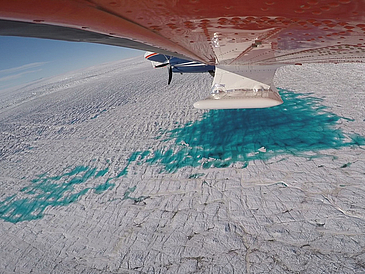Over a third of the worldwide increase in sea levels can be traced to the massive retreat of Greenland’s ice sheet. For the past twenty years, researchers have been observing with concern how climate change is melting the ice masses on and around Greenland. The role played in this process by ocean warming is the topic of a new consortium project which took up work on May 1, 2017. The project titled “Greenland Ice Sheet /Ocean Interaction” (GROCE) involves researchers at eight German universities and research centers. It is being funded over an eight year period by the German Ministry for Education and Research (BMBF) in an amount of 3.5 million euro.
The University of Bremen is part of it
Of the ten subprojects, the University of Bremen is hosting two, which will receive almost a million euro of the total funding amount. Bremen researcher Professor Monika Rhein from the Institute of Environmental Physics and the MARUM – Center for Marin Environmental Sciences will be investigating the role of melt water in the European North Atlantic. Professor Ben Marzeion from the Institute of Geography is researching ocean-ice interaction on the Greenland glaciers.
The other institutions participating in the project are the universities of Bonn, Dresden, Kaiserslautern and Erlangen-Nürnberg as well as the GEOMAR – Helmholtz Center for Ocean Research, the Leibniz Institute for Baltic Sea Research, and the Alfred Wegener Institute, Helmholtz Center for Polar and Marine Research (AWI), which is also project coordinator.
Glaciers accelerate their pace of flow
One cause of ice-melt is that the glaciers’ pace of flow is accelerating and therefore more ice is being lost to the ocean than can be replaced by snowfall inland. On the other hand, in summer the surface area of melting ice has become so large that in many places it leads to the formation of lakes and fast flowing streams, which in turn transport the melt water to the sea much faster. “We have teamed up in an effort to reach a better understanding of the complex interplay between the Greenland ice sheet, the Earth’s crust, the atmosphere, and the ocean. The key to answering our research question lies in integrating participants’ excellent expertise in Earth observation and numerical modeling, which the project brings together for the first time”, says project leader, Professor Torsten Kanzow, an oceanographer at the Alfred Wegener Institute.
Airborne, seaborne, and field campaigns
Both this year and next, the oceanographers, glaciologists and geodesists will carry out coordinated airborne, seaborne, and field campaigns in the North East of Greenland. The measurements they collect will then be evaluated with the aid of special computer models. The results are expected to enable the integration of ice sheet and the ocean interactions in more realistic climate models, thus making it possible to reach better predictions on changes in sea level and ocean currents.
Glaciers in North East Greenland play special role
A central focus of the field-measurement campaign will be on the 79-Degree-North Glacier in the North East of Greenland. This glacier plays a special role compared to other glaciers in Greenland because in contrast to ice flows on the West and South coast it has remained stable for a longer time. But today, evidence is accumulating that the 79-Degree-North Glacier may also have started to melt. It does, however, still have a glacial tongue stretching some 80 miles out to sea.
If you would like to have more information on this topic, feel free to contact:
University of Bremen
Institute of Environmental Physics and MARUM – Center for Marine Environmental Sciences
Prof.Dr. Monika Rhein
Phone: +49 421 218-62160
email: mrheinprotect me ?!physik.uni-bremenprotect me ?!.de
Prof.Dr. Ben Marzeion
Institute of Geography
Phone: +49 421 218-67170
email: ben.marzeionprotect me ?!uni-bremenprotect me ?!.de

